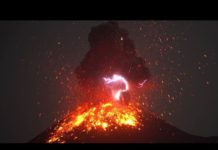Lava is molten rock generated by geothermal energy and expelled through fractures in planetary crust or in an eruption, usually at temperatures from 700 to 1,200 °C (1,292 to 2,192 °F). The structures resulting from subsequent solidification and cooling are also sometimes described as lava. The molten rock is formed in the interior of some planets, including Earth, and some of their satellites, though such material located below the crust is referred to by other terms.
A lava flow is a moving outpouring of lava created during a non-explosive effusive eruption. When it has stopped moving, lava solidifies to form igneous rock. The term lava flow is commonly shortened to lava. Although lava can be up to 100,000 times more viscous than water, lava can flow great distances before cooling and solidifying because of its thixotropic and shear thinning properties.
Lava sampling: Why do we do it?
Hot lava samples provide important information about what’s going on in a volcano’s magma chambers.
We know from laboratory experiments that the more magnesium there is in magma, the hotter it is. Chemical analysis, therefore, provides the means not only to determine the crystallization history of lava but also to establish the temperature at which it was erupted.
For example, Kilauea’s 1997 lavas are chemically different from lavas erupted from 1985 to 1997. Chemical analyses show that magma was supplied by two distinct magma bodies.
Video Copyright © USGS










![Scientists discover 36-million-year geological cycle that drives biodiversity Mesozoic mural depicting different ocean species that have evolved through time. [Credit: Smithsonian Institution]](https://www.geologypage.com/wp-content/uploads/2023/08/Scientists-discover-36-million-year-geological-cycle-that-drives-biodiversity-GeologyPage-218x150.jpg)





